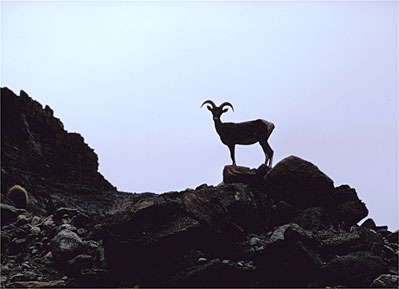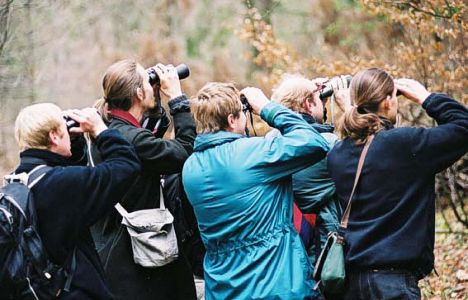
| Issue 4, Winter 2003-04 | ||||
In Depth: Wildlife Linkages Are the Key to Wilderness Healthby Kim Vacariu
Scientists have developed conclusive evidence over the past two decades that the long-term survival of many wildlife species cannot be guaranteed simply through the protection of isolated islands of habitat. Without the ability to move safely across large landscapes in search of food and mates, wide-ranging species like wolves and bears— often the backbone of ecosystem health — can be killed on highways or die entangled in fences, lose genetic viability, and suffer steady population reductions. Such threats are the precursors to extirpation and extinction, and in worst-case scenarios could someday result in wilderness and wildlands that, while visually spectacular, are biologically barren.
To prevent these threats from doing serious damage to mountain lions, black bears, jaguars, and other native species, in existing protected areas — particularly wilderness or wildland “cores,” strong efforts should be made to connect these habitats to one another via wildlife linkages that permit the continued movement of species across their native ranges. In this regard, wilderness proposals would be best designed for easy connection to adjacent corridors essential to regional wildlife movement. Wildlife linkages, which range in length and breadth to accommodate different species, geographic features, and distances between protected areas, typically will need to include a mix of public and private lands managed to protect or restore wildlife-friendly habitat. Tools used to protect wildlife linkages include conservation easements that protect important ecological values, highway crossing structures for wildlife, fence removal, open space purchase programs, purchase of development rights, grazing lease buy-outs, and other state or federal economic incentives that encourage private landowners to think twice before automatically subdividing as a solution to financial problems.
However, protecting linkages through these means is no easy proposition. Modern conservation planning now recogonizes the critical nature of landscape connections, but simply mapping where these linkages are needed is only a first step in a very difficult process, a process that hinges on altering deeply-held traditional beliefs relating to private property rights and the power of humans over Nature. Before large-scale, on-the-ground linkage protection can be achieved, a broadly targeted, long-term informational campaign needs to address the need for a dramatic shift in the way land owners and managers view the “value” of land. And while this shift must incorporate adoption of sometimes esoteric values, like ecological “capital” and “ecosystem services,” it must also be grounded in tangible income opportunities or other clear benefits that can provide win-win situations for land owners.
With new generations likely to better understand the need for conservation and the increased equity values that conserved lands will represent in the future, it’s likely that desires to protect wildlife linkages by private landowners will become more common in decades to come. But the worry is that, with the alarming pace of rural land subdivision in Arizona today, and the associated landscape fragmentation by highways and fencing that accompany such sprawl, there may not be enough time to make that transition before the most vital linkages are permanently lost.
In Arizona’s borderlands region, federal security concerns are quickly overriding the viability of historic cross-border wildlife linkages and their importance in protecting the region’s natural heritage. Impenetrable high-rise steel fencing, new roads, all-night stadium lighting, low-flying aircraft patrols, and other infrastructure will, if not alleviated soon, promise the end of Arizona jaguar sightings and other sensitive species that formerly called Arizona home.
Such imminent threats to wildlife linkages between protected areas have a direct bearing on the ecological health of wilderness. Without the continuing regulatory effects of a full suite of carnivores, even the wildest of habitats will be degraded as food chain interruptions lead to unnatural explosions in prey species populations, resulting in a cascade of other negative interactions through the ecosystem. To prevent this situation, we need to ensure that wildlife is able to travel from one safe haven to another. Based on this need for relatively immediate actions to preserve linkages,
there are several approaches to consider as Kim Vacariu is the Southwest Representative for the Wildlands Project. For more information about the Wildlands Project’s “Room to Roam” endangered linkages campaign, see www.wildlandsproject.org/roomtoroam
|
||||

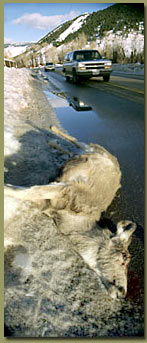
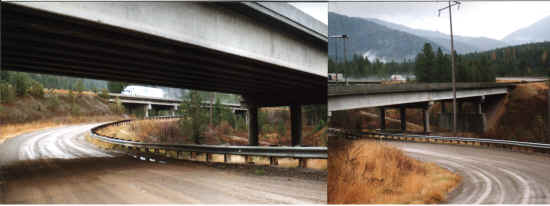
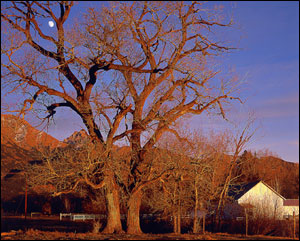

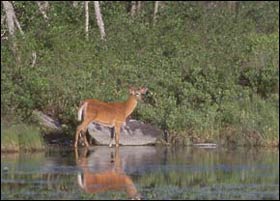 compliments
to longer-term informational campaigns. Most importantly, wilderness
proposals and other land protection initiatives need to be designed
in a way that does not preclude connectivity with surrounding protected
areas. Further, when mapping lands to be protected through other methods,
such as in wildlands networks, regional zoning plans, open space acquisition
programs, or habitat conservation plans, thought should be given to
locating wildlife linkages in areas where land is already conserved
or most likely to be protected in the future. Finally, effective citizen
opposition to proposals that will obstruct existing wildlife linkages
between protected areas is essential if the future is to include wilderness
and wildlands that are both beautiful and teeming with healthy
wildlife.
compliments
to longer-term informational campaigns. Most importantly, wilderness
proposals and other land protection initiatives need to be designed
in a way that does not preclude connectivity with surrounding protected
areas. Further, when mapping lands to be protected through other methods,
such as in wildlands networks, regional zoning plans, open space acquisition
programs, or habitat conservation plans, thought should be given to
locating wildlife linkages in areas where land is already conserved
or most likely to be protected in the future. Finally, effective citizen
opposition to proposals that will obstruct existing wildlife linkages
between protected areas is essential if the future is to include wilderness
and wildlands that are both beautiful and teeming with healthy
wildlife. 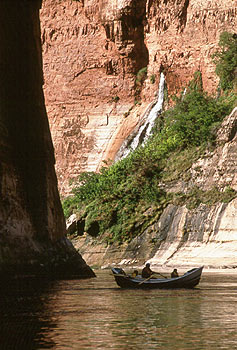
 In
Arizona, winter is the time to get outside, take the dog or kids, and explore
some of our glorious natural areas! Find your favorite wilderness area. Trek
an untrekked trail. And share with others what you find. Take a look at our
upcoming list of inventory trips, meetings, workshops, and other wildly fun
events.
In
Arizona, winter is the time to get outside, take the dog or kids, and explore
some of our glorious natural areas! Find your favorite wilderness area. Trek
an untrekked trail. And share with others what you find. Take a look at our
upcoming list of inventory trips, meetings, workshops, and other wildly fun
events. 